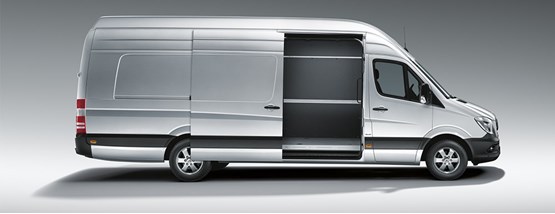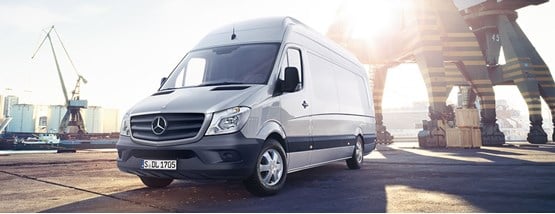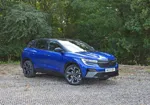Review
Mercedes-Benz's Sprinter continues to set the pace introducing technology in tune with the changing marketplace, as Liam Campbell finds in the first look.
Ahead of its third-generation Sprinter van launch this year, Mercedes-Benz had a sneak preview in Stuttgart.
The ‘Innovation Campus’ showcased a whole range of exciting new technology, which also offered a glimpse into the future of transportation.
Since it replaced the aging TN van in 1995, the Mercedes-Benz Sprinter has achieved more than 3.3 million sales worldwide.
It’s also managed to achieve many firsts along the way, including the first van to feature ESP (electronic stability control), ABS (anti-lock brake system) and sidewind assist, and the first European van to go on sale in the US.
However, the curtain is finally dawning on the second-generation Sprinter, which hit the market in 2006.
Teaser images of the replacement model were revealed at the North American Commercial Vehicle Show in September, although the finished product is yet to be unveiled.
The Sprinter has always been a firm favourite among fleets for its strong residual values and aftersales service, but Mercedes-Benz wants to take this one step further by raising the bar an extra couple of notches in terms of connectivity.
“The marketplace is changing and so should we,” said Volker Mornhinweg, head of Mercedes-Benz Vans.
“The growth in online shopping, above all, is bringing new challenges. The level of expectation is also rising, so transport companies have to constantly offer faster, more traceable and more flexible delivery services.
"The new Sprinter has been developed to meet these challenges”.
Video source: OldBenz YouTube
Design and architecture
Visually, the new Sprinter differs significantly compared with the current generation.
The thin, horizontal headlights create a more aggressive look, while the pronounced, streamlined grille gives it a sporty edge which also helps with aerodynamics to increase fuel efficiency.
With regards to chassis architecture, very little has changed from the current generation.
There are three wheelbases, four load lengths and three roof heights, which, when combined with the various nominal gross vehicle weights, will mean more than 1,000 variants to choose from.
Gross vehicle weights are expected to remain the same at between three and five tonnes although payloads are expected to increase ever so slightly to around 1,650kg on the smallest 3.5-tonne model thanks to the option of front-wheel drive.
Front-wheel drive models will also have an 80mm lower loading height, making life easier for multi-drop couriers.
Sector-leading shelving solutions provide for tidy and orderly load compartments and, for the first time, the telematics system can be integrated with the load space to enable the driver and fleet manager to keep an eye on the items on board in real time.

Engine and driveline
Daimler has said the Sprinter will be offered with four power ratings, although it hasn’t announced the outputs or the powerplants.
It’s expected, however, that the current 2.1-litre (2,143cc) OM651 and 3.0-litre V6 (2,987cc) OM642 engine will remain and outputs won’t stray too far from the current 95PS/250Nm, 130PS/305Nm, 165PS/260Nm and 192PS/440Nm.
For the first time, the Sprinter will be offered in front-wheel drive which, along with the practical benefits, will increase efficiency.
For those wanting the traction, handling and perceived durability of the traditional Sprinter, rear-wheel drive models will also be available, as will a 4x4 in the future.
All engines will be hooked to a six-speed manual transmission, although the 7G Tronic automatic will be offered as an option.
In addition to the combustion engines, Mercedes-Benz has also confirmed an electric version from 2019.
“We are convinced by the necessity of electric drive in our vans, especially in city centre applications.
That said, electrification of the commercial fleet is not an end in itself, but follows the same principles as a classic drive when it comes to commercial feasibility,” said Mornhinweg.

Cab and interior
There will be four interior grades on the new Sprinter ranging from the trades-targeted basic interior to the luxurious one which is aimed at the lifestyle and VIP transport sectors.
The entry-level model interior has few creature comforts and it doesn’t even have a radio.
What it lacks in sophistication, it more than makes up for in practicality with a wide range of storage compartments dotted around.
Keyless entry and start is standard, surprisingly, which will increase its attraction to multi-drop couriers, and the air vents are built to ‘passenger car standards’.
Recognising its appeal to fleets, Mercedes-Benz offers its Pro connect services on all interior grades, even the base model (see panel below).
The next interior up adds steering-wheel mounted controls and a housing for the infotainment system (which Mercedes-Benz has called the ‘skateboard’) at the top of the dashboard which includes additional air-vents.
On the third-tier interior, the hard plastics are replaced by a higher quality material and there’s a high-resolution screen in place of the radio slot.
There are power sockets to charge tools and devices, and there is a lidded storage compartment on top of the dash. It’s from this trim that the automatic transmission will be available.
The flagship interior is reserved for the high-end user, with its piano black finish on the fascia and chrome highlights.
There’s also a more advanced infotainment system with sat-nav, smartphone mirror-linking and a 10.25-inch widescreen display.

Connectivity
Mercedes-Benz maintains that the new connected systems aboard the Sprinter signal a new age of light commercial vehicles (LCVs).
Rather than basing its connected systems on an existing platform from a third party, Mercedes-Benz has brought all the expertise in-house so the systems can be fully integrated and tailored to the new van.
The German manufacturer argues we should stop viewing the Sprinter as van; instead it is an arm in a much wider integrated transport and mobility service.
With its connectivity hardware and the Mercedes Pro connect services, the new Sprinter becomes part of the Internet of Things.
Mercedes Pro is the company’s web-based telematics system, which offers all the usual fleet management solutions like vehicle logistics, fleet communications, maintenance management, accident recovery and a digital vehicle log.
The fleet communication service enables tradespeople to be informed about job changes and duly rerouted while on the road, for example.
Customer addresses for the next job are relayed directly to the system, ruling out misunderstandings in communications between vehicle coordinator and driver.
Vehicle information such as location, fuel level or maintenance intervals can be retrieved in real time.
These can be fully integrated without the need to retrofit devices, which can prove costly and time consuming.
By offering this, Mercedes is hoping the Sprinter will be taken up by medium-sized and smaller fleets, too.
















